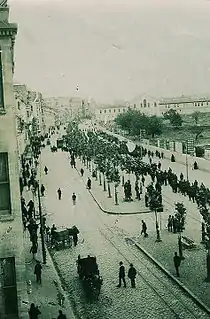Pangaltı Armenian Cemetery
The Pangaltı Armenian Cemetery was located in the Pangaltı quarter of Istanbul near Taksim Square and originally belonged to the Surp Agop Armenian Hospital.[1] In the 1930s it was demolished and was replaced with the Taksim Gezi Park, Divan Hotel, Hilton Hotel, Hyatt Regency Hotel, and the TRT Radio Buildings.[2][3][4]
 A funeral procession in front of the Pangalti Armenian Cemetery, 1913 | |
| Details | |
|---|---|
| Established | c. 1560 - 1930 |
| Location | |
| Coordinates | 41.04225°N 28.98825°E |
| Type | Private Armenian Cemetery |
| Owned by | Surp Agop Armenian Hospital |
It is considered to have been the largest non-Muslim cemetery in Istanbul's history.[5][6]
History

The Pangaltı cemetery was founded in 1560 after an epidemic caused the Armenian community of Constantinople to petition Sultan Suleyman.[7] It was enlarged in 1780 and enclosed by a wall in 1853.[8] The Pera district was very close to the cemetery, so an outbreak of cholera in 1865 led the government to ban burials and allocate them to the Şişli Armenian Cemetery instead.[4]
The Pangaltı cemetery was demolished in the 1930s[6] and in 1939 its marble tombstones were sold[9][1] and used to build the Gezi Park's fountains and stairs.[10][11][12][13][2][14] Other parts of the cemetery were used to construct Eminönü square which was, along with Gezi Park, designed by city planner Henri Prost.[15][16][11][2][13][12][14]
In 2013, during excavation work for the reconstruction of Taksim square, 16 tombstones from the Armenian cemetery were discovered.[17]
Legal Case
In 1932 Mesrob Naroyan, the Armenian Patriarchate of Constantinople, filed a lawsuit for the return of the property,[7] but the Istanbul Municipality argued that he had been a legal non-entity in Turkey since 1916 (the position of Armenian Patriarchate had been officially suspended in 1916 as part of the Armenian Genocide) [18] and therefore had no title to the land, even though he still functioned at the Armenian Patriarchate of Constantinople in Kumkapı, Istanbul.[7][19]
The Patriarchate acknowledged the lack of title, but argued legitimacy to represent the cemetery on behalf of both the Armenian Catholic Community and the Surp Agop Armenian Hospital.[19]
The commission to investigate land ownership found the Patriarch's claims groundless, so title remained with the Istanbul municipality and the third party owners.[7][19]
References
- Tan, Gokhan (2011-07-24). "Varolmayanın tescili". Radikal (in Turkish). Retrieved 21 December 2012.
- Nalci, Tamar. "Istanbul Radio was an Armenian Cemetery". Midyat (in Turkish). Archived from the original on 20 August 2017. Retrieved 21 December 2012.
- Koc, Vehbi (1977). My life story: the autobiography of a Turkish businessman. Vehbi Koç Foundation. p. 238.
- Tuğlacı, Pars (1991). İstanbul Ermeni kiliseleri. İstanbul: Pars Yayın. ISBN 9789757423003.
- Büyükünal, Feriha (2006). Bir zaman tüneli: Beyoğlu (in Turkish) (1. baskı. ed.). Güneşli, İstanbul: Doğan Kitap. p. 21. ISBN 9789752934337.
- Greenhouse, Emile (June 28, 2013). "The Armenian Past of Taksim Square". The New Yorker.
- Nalci, Tamar (August 27, 2011). "Bir Gasp Hikâyesi". Bianet (in Turkish). Retrieved 21 December 2012.
- Göksu Özdoğan, Günay (2009). Türkiye'de Ermeniler : cemaat, birey, yurttaş (in Turkish) (1. baskı. ed.). Şişli, İstanbul: İstanbul Bilgi Üniversitesi Yayınları. ISBN 9786053990956.
- "In Istanbul's Heart, Leader's Obsession, Perhaps Achilles' Heel". The New York Times. 2013-06-07. Retrieved 2013-06-27.
- "Learning From Taksim Square: Architecture, State Power, and Public Space In Istanbul". The Huffington Post. 2013-06-14. Retrieved 2013-06-27.
- Karakasli, Karin (June 6, 2013). "Geçmise direnmek". Agos (in Turkish). Archived from the original on January 6, 2014.
Mezar taslarinin çogu, sehir planlamacisi Henri Prost’un tasarladigi yeni Eminönü Meydani’nin onariminda ve Gezi Parki’nin merdivenlerinin yapiminda kullanilir.
- Çetintaş, Burak (December 2012). "İstanbul: Şehri yıkarak tarihe geçenler". NTV Tarih (in Turkish) (47).
- Pamukciyan, Kevork (2003). Ermeni kaynaklarından tarihe katkılar (in Turkish). İstanbul: Aras Yayıncılık. ISBN 9757265535.
- Perrier, Guillaume (6/11/2013). "Sous le parc occupé d'Istanbul, un cimetière arménien". Le Monde (in French).
Le terrain donné par le sultan se trouve aujourd'hui au nord de la place Taksim, occupé par une partie du parc Gezi, quelques hôtels de luxe, des immeubles et un bâtiment de la Radio télévision turque (TRT). De ce vaste terrain, seul l'hôpital Sourp Hagop subsiste. Le reste, qui appartenait à la communauté, a été spolié par la République. Le cimetière a été entièrement détruit dans les années 1930 et ses pierres tombales ont été réutilisées dans la construction d'un nouveau centre urbain par l'urbaniste Henri Prost, l'auteur du plan d'aménagement d'Istanbul choisi par Atatürk.
Check date values in:|date=(help) - Tan, Gokhan (2011-07-24). "Varolmayanın tescili". Radikal (in Turkish). Retrieved 21 December 2012.
Mezartaşlarının çoğu, şehir planlamacısı Henri Prost'un tasarladığı yeni Eminönü Meydanı'nın onarımında ve Gezi Parkı'nın merdivenlerinin yapımında kullanılır.
- Tarih ve toplum (in Turkish) (Issues: 37-48 ed.). Taruh ve Toplum: Aylık Ansiklopedik Dergi. 1987. p. 86. Retrieved 20 January 2013.
Mezar taşlarının büyük kısmı ise, Eminönü Meydanfnın onannıında kullamlmıştır.
- ERTÜRK, Ali Ekber (29 June 2013). "Taksim'de Ermeni mezarları çıktı". Aksam (in Turkish).
- copyed., Zaven Der Yeghiayan,... ; transl. from the Armenian by Ared Misirliyan; Ghazarian, annotated by Vatche (2002). My patriarchal memoirs. Barrington (R.I.): Mayreni publ. ISBN 9781931834056.
- Cagatay, Soner (2006-05-02). Islam, secularism, and nationalism in modern Turkey: who is a Turk?. Routledge. p. 135. ISBN 9781134174485. Retrieved 21 December 2012.